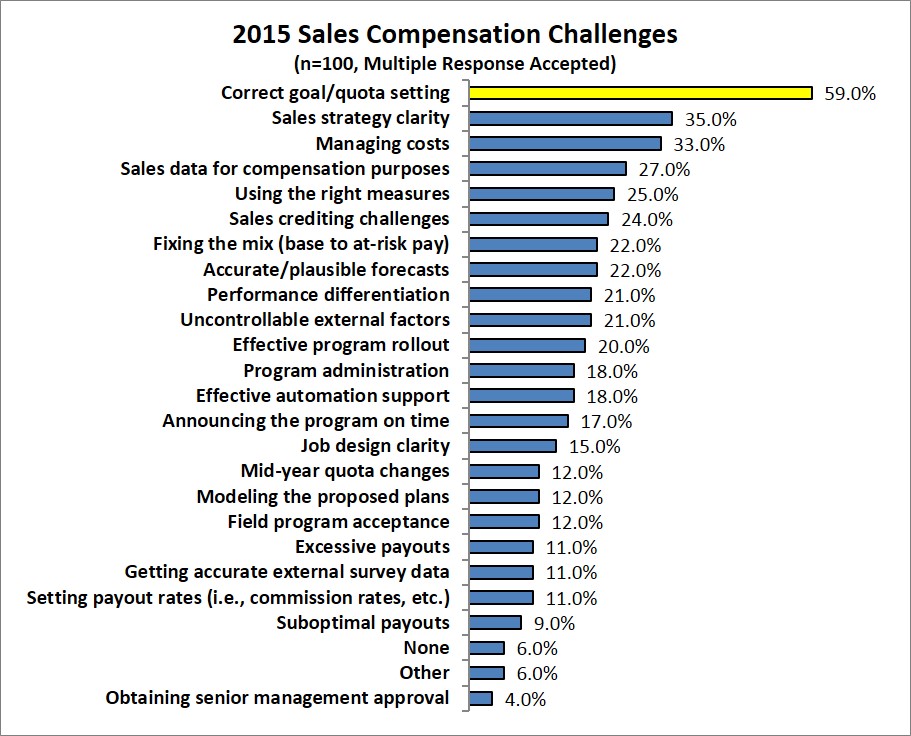Five Best Sales Quotas Practices
Sales quotas are a popular but imperfect sales management tool. Each year, sales leadership allocates the company’s annual forecast to the selling resources. The process is loaded with noise, challenge and drama. Logically, it seems that these annual, year-after-year attempts to get quotas right would eventually yield a highly tuned system, celebrated by all. Unfortunately, that is not the case. More than 50% of the participating companies reported “correct goal/quota setting” as the No. 1 challenge facing the sales compensation program in Alexander Group’s annual Sales Compensation Trends Survey. In 2015, that number reached 59%.

The sales quota program is a performance accountability system. Such systems can create a sometimes tense, charged environment. Because setting quotas is both science and art, it is open to errors and criticisms from all fronts.
Follow these five best practices to improve your sales quota program.
- Embrace Sales Quotas
- Let Customer Knowledge Drive Allocation Process
- Use Potential to Fine-Tune Quotas
- Make Quotas Active
- Manage Crediting, Exceptions and Mid-Year Changes
#1: Embrace Sales Quotas
Yes, sales quotas drive performance accountability (and produce noise). More importantly, they offer a broad and robust sales management platform for sales planning conversations and coaching. Sales quota allocation provides an excellent process to judge current sales results and assess future sales opportunities. In many respects, it is one of sales management’s most important planning and management tools. Use quota results to recognize success and identify performance improvement opportunities.
#2: Let Customer Knowledge Drive Allocation Process
Should sales personnel be involved in setting their own quotas? Conventional wisdom encourages seller involvement in the annual quota allocation process. When sales management involves sales personnel in the process, they become more engaged and committed to achieving their sales objectives. Yes, but. There is a wide arc of selling. For example, some sellers have only one account, such as strategic account managers (SAMs). These sellers work year-round with the same buyers at the assigned customer, often working on large complex deals featuring high-revenue opportunities. Of course, we would want the SAMs to be deeply involved in the quota allocation process. Who else knows more about the account—its revenue potential—than the SAM assigned to the account? Meanwhile, an inbound sales associate taking calls driven by marketing campaigns has little personal knowledge of sales potential. It is best to use information about marketing campaigns, their duration, offer and historical impact to help set quotas for telesales associates. Extent of customer knowledge determines the appropriate involvement of sales personnel. The more they know about the accounts, the more involved they are in the process. The less they know about the accounts, the less they participate in suggesting the right quota.
#3: Use Potential to Fine-Tune Quotas
Between the two selling extremes of strategic account managers and telesales associates exists many types of sellers; the most common is the account manager. Account managers have a specific set of accounts, often called “named” accounts. Some of these accounts are very active and well-known to the account manager, others less so. We would like our account managers actively involved in the quota allocation process. We want them to understand both their active and inactive accounts. Additionally, sales management can employ strong account-by-account analytics to create predictive potential estimates for accounts. Combining the account manager’s view of next year’s potential with the calculated estimates by sales management offers a dialog opportunity known as the “top-down/bottom-up” quota allocation process where both parties contribute to establishing the annual quota. This methodology trumps quota allocation processes that take last year’s performance and add a flat growth rate.
#4: Make Quotas Active
Quota performance, quota reporting and quota reviews should be in the lifeblood of sales management narrative and operations. Quota performance should be ingrained in the leadership messaging to the sales force. Remind the sales team—and often—of the shared quota commitments. Quota reporting should be available to all, including sales force-wide numbers down to individual performance. They should not be private—let them be transparent. Let them see how other sellers are doing and how they compare. Use quota performance to inform sales coaching and management efforts. Quotas should not reside solely on spreadsheets; make them an active part of the management process.
#5: Manage Crediting, Exceptions and Mid-Year Changes
Walk the quota ramparts to ensure the integrity of the program. Make sure the program does not offer excessive double crediting. Ten percent double crediting or less is a good starting benchmark to assess the extent of double crediting. To calculate double crediting, take compensable revenue less actual revenue divided by actual revenue. Limit mid-year exceptions. Publish definitive and restrictive rules when sales management can provide “quota relief.” Use a quota review board to approve all quota adjustments. Only consider sales force-wide mid-year changes when the company has restated it goals and publish those new goals to the stockholders/owners.
Sales Quota Traps
Here are two common sales quota “traps” that sales leaders can avoid. First, do not attempt to assign quotas for unpredictable, large orders. Such orders can upend a quota system. Pay them on a separate schedule. Second, keep new products out of the annual quota, unless product management has a proven track record hitting launch dates and accurately estimating volume. Otherwise, leave them out of the quota. Reward them with a SPIFF.
Remarks
Quotas are more often right than wrong; however, the accompanying noise factor disproportionately distracts from the overall confidence of the allocated quotas. In other words, your quotas may not be that bad after all. And, follow the five suggestions: embrace sales quotas; let customer knowledge drive allocation process; use potential to fine-tune quotas; make quotas active; and manage crediting, exceptions and mid-year changes. Of course, avoid the sales quota traps of mega orders and new products.
Learn more about the Alexander Group’s sales compensation and sales quotas services.
